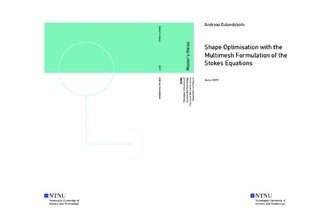| dc.description.abstract | Denne oppgåva utforsker moglegheitene av å kombinere den nyleg føreslått "multimesh finite element method" med gradientbasert formoptimering. Insentivet til dette er å redusere berekningskostnaden relatert til deformasjonar av berekningsdomenet, som typisk er assosiert med standardformuleringa av "The finite element method". Problemet som er studert er "The Stokes-drag problem", der funksjonen som beskriv friksjon i ei væske er optimert med tanke på den relative posisjonering av lekamar i eit mangepartikkel system. I problemformulasjonen er eit sett av partielle differensialligninger kjent som "The Stokes equations", brukt for å beskrive hastigheita til den omliggande væska.
"Multimesh FEM" er ei metode som nyttar seg av mange uavhengige maskeringar av berekningsdomenet. Desse maskeringane kan då bli assosiert med ulike komponentar i mangepartikkel systemet og på denne måten kan metoden unngå berekningskostnaden relatert til endring i geometrien av berekningsdomenet. I kraft av dette er "multimesh FEM"-metoden spesielt godt eigna til å løyse den type optimeringsproblem som er studert i denne oppgåva. For å kunne kombinere denne metoden med gradientbasert formoptimering er det nødvendig å finne ein gradient representasjon som er kompatibel med ei oppdeling av berekningsdomenet.
Det nye bidraget i denne oppgåva er den analytiske utrekning av ein gradient representasjon for "The Stokes-drag problem", som er kompatibel med "multimesh" formuleringa. Den deriverte av energi dissipasjons funksjonen er utrekna ved hjelp av «The adjoint approach» og ved å nytte Hadamard teoremet. I utrekninga er den sterke forma av alle partielle differensial ligningar brukt. Berekningsdomenet er oppdelt i mange deldomene og kontinuitetbetingelsa for hastigheit og trykk er innført over grensene mellom dei ulike domena. Hadamard formuleringa for eit oppdelt berekningsdomene er funnen å være lik Hadamard formuleringa frå eit enkelt berekningsdomene. Numeriske eksperiment i denne oppgåva har verifisert presisjonen til gradienten i mange ulike situasjonar. Det er vist at gradienten har akseptabel presisjon rundt ekstremalpunkt.
Ved å bruke eit system med turbinar i ein tidevannstrøm som testproblem, har metoden vist seg å reprodusere resultat frå litteraturen. Det er funne ut at tidsbruken assosiert med gradientevalueringa og oppdatering av domene-maskeringane, er neglisjerbar samanlikna med tida det tek å løyse det lineære systemet assosiert med "The stokes equations". Mange ulike applikasjonar for den nye metoden er føreslått. | |
| dc.description.abstract | This thesis explores the possibilities for combining the recently proposed multimesh finite element method with gradient based shape optimisation. The incentive is to reduce the computational cost related to deformations of the computational domain, that is associated with the standard finite element method. The problem that is studied is the Stokes-drag problem, where the optimisation of energy dissipation into heat, with regards to the optimal placement of objects in a multi-body system, is considered. In the problem formulation, the Stokes equations are used as the constraining partial differential equations.
Multimesh FEM relies on multiple independent meshes that can be associated with separate parts in a multi-body system. This way the method avoids the computational cost of re-meshing. As such, the scheme is particularly well suited to handle the kind of problems that is studied in this thesis. However, in order to combine this scheme with gradient based shape optimisation it is necessary to develop a gradient representation that is compatible with the partitioning of the domain.
The novel contribution in this work is the analytical derivation of a gradient representation for the Stokes-drag problem, with basis in the multimesh scheme. The shape derivative of the drag functional is derived using the adjoint approach and corollaries from the Hadamard theorem. In the derivation all constraint equations are considered on their strong form. The computational domain is considered in a multi-domain setting where the interface conditions, from the multimesh FEM formulation of the Stokes equations, are introduced on their strong form. The resulting Hadamard formulation of the shape derivative is found to be equivalent to the expression found from a single-domain analysis. Numerical experiments conducted in this work, have verified the accuracy of the gradient in several different scenarios. In particular, the gradient is demonstrated to have acceptable precision around extrema points which is further improved by refining the mesh.
Using layout optimisation of a tidal turbine farm as a benchmark, the performance of the combined multimesh shape optimisation scheme is demonstrated to replicate results from the literature. The time consumption associated with gradient evaluations and mesh update is found to be negligible compared to other operations such as assembly of and solving the linear system. Several possible applications of the developed scheme are proposed and suggestions for future work are made. | |
